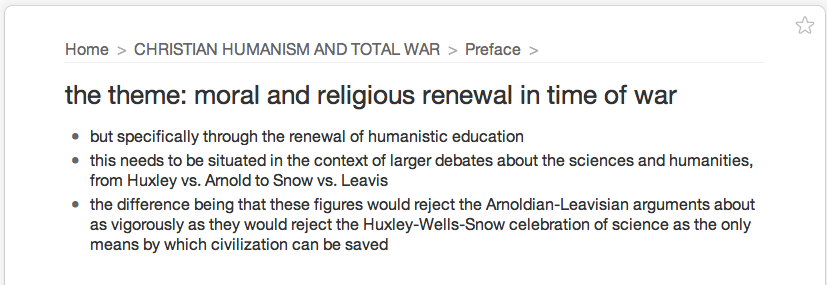
So when I think about software that could seriously alter the way I write, one of the first examples that comes to mind is Workflowy. Now, Workflowy seems to have been designed largely as a task manager, but I’m intrigued by it because its design brings a certain degree of desirable structure to what Giles Turnbull once memorably called the big-ass text file, or BATF.
The BATF idea is simple: put all of your thoughts, ideas, plans, tasks, and drafts in one, well, big-ass text file, and then search inside of it when you need to find something. No folders, no nested hierarchical stuff, just text — though possibly fitted out with tags or other searchable metadata to make it easier to find stuff. (And then, perhaps, move something into its own file when a draft is completed. But only if you want to.) The primary virtue of the BATF is that you eliminate the time spent creating new files and deciding where to put them. You just type. So there’s less friction between the idea and the act of recording it.
(By the way, the Drafts app for iOS has a command for appending the text you type to a selected Dropbox file, which would agreeably strengthen the BATF method for people who use iPhones and iPads: just type out your thoughts and tap that command, and the text, helpfully date-stamped, is added to your BATF and will be visible when you next open it on your computer.).
It seems to me that Notational Velocity and its higher-powered clone nvALT offer a slightly more sophisticated version of the BATF idea: you don’t have just one file, but you have one window into which you type, and searching replaces sorting. I love nvALT and throw almost everything textual into it — I’m typing in it right now, though at some point I’ll probably move this over to BBEdit, just out of ancient habit.
It is the nature of the BATF and nvALT to be unstructured, which is why you might have to think about how to create relevant metadata. And there’s no really visible structure, which can sometimes be disorienting. And here’s where Workflowy comes in.
A Workflowy document is an outline: if you want to use it well you’ll need to master just a handful of keyboard shortcuts for indenting and outdenting and moving up and moving down, but once you do that you’ll be free just to type your ideas. You can, as with all other outliners that I know of, expand or collapse nodes, so you can focus better on what you want to work on. But Workflowy has a distinctive feature that I haven’t seen in another outliner: the ability to zoom in on a single node and make everything else disappear, just by clicking on a handle — and then zoom out again, just by clicking on a word or phrase.
Here’s a screenshot of a part of my Workflowy document:
This is from an in-progress outline of the book I’m working on. Here I’m working on the section of the preface to the book in which I’m identifying the book’s chief theme. Nothing else is visible on screen, except, at the top of the document, its higher levels: I can click on “Preface” to see the whole of the Preface; or on “Christian Humanism and Total War” to see the complete outline of the book; or on “Home” to see everything I’ve put into this document, which might include everything from grocery lists to upcoming travel plans. And then from that Home view I can drill down into any the document at any depth I choose. In other words, Workflowy could become, if I chose, a BATF with an adjustable-view organizational structure. Which is pretty cool.
All that said, I’m probably not going to be using Workflowy. It’s a web app, which means that my data is on somebody’s server, something I don’t like (though it does have nice export options). And I can approximate many, though not all, of its features in OmniOutliner and TaskPaper, which reside on my computer. TaskPaper is not a real outliner — more than a couple of levels of indentation and things start getting unmanageable — but its files are plain text. OmniOutliner files, by contrast, are basically OPML/XML — readable by multiple apps, but not as plain as I’d like. Plus, OmniOutliner is plagued by feature bloat that makes it hard to use well.
I’d love to see a desktop version of WorkFlowy — as far as I know, there’s nothing quite like it. There are plenty of mind-mapping apps, most notable among them being the venerable and much-loved Tinderbox, but those have never worked for me. The linearity of the outline seems to soothe my turbulent mind. A desktop zoomable outliner might stand a chance of genuinely changing the way I think and write.


Here is me (and Conor) revealing my secret shame.
http://fredrikdeboer.com/2013/05/11/confession-i-dont-take-notes/
My God, man, keep it to yourself!
Actually, I never took notes in class either. Instead, I doodled. I developed this style of crosshatching that I would fill page after page with; somehow it helped me to remember what the teacher was saying. If I tried to take notes I would get distracted and lose the thread. Once in college I finished a page of cross-hatching and the guy who sad behind me said "I'll give you five bucks for that."
But when I write, especially when it's something big,outlining helps me a lot.